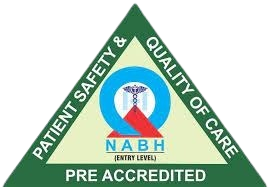Pregnancy is a beautiful journey, but it comes with its share of challenges and health risks. Among the most serious complications are Preeclampsia and Eclampsia — conditions that can pose a threat to both mother and baby if not recognized and treated early.
Dr. Neha Bajaj, an experienced gynecologist at Kailash Hospital, shares vital insights into these conditions to help expecting mothers stay informed and safe.
What is Preeclampsia ?
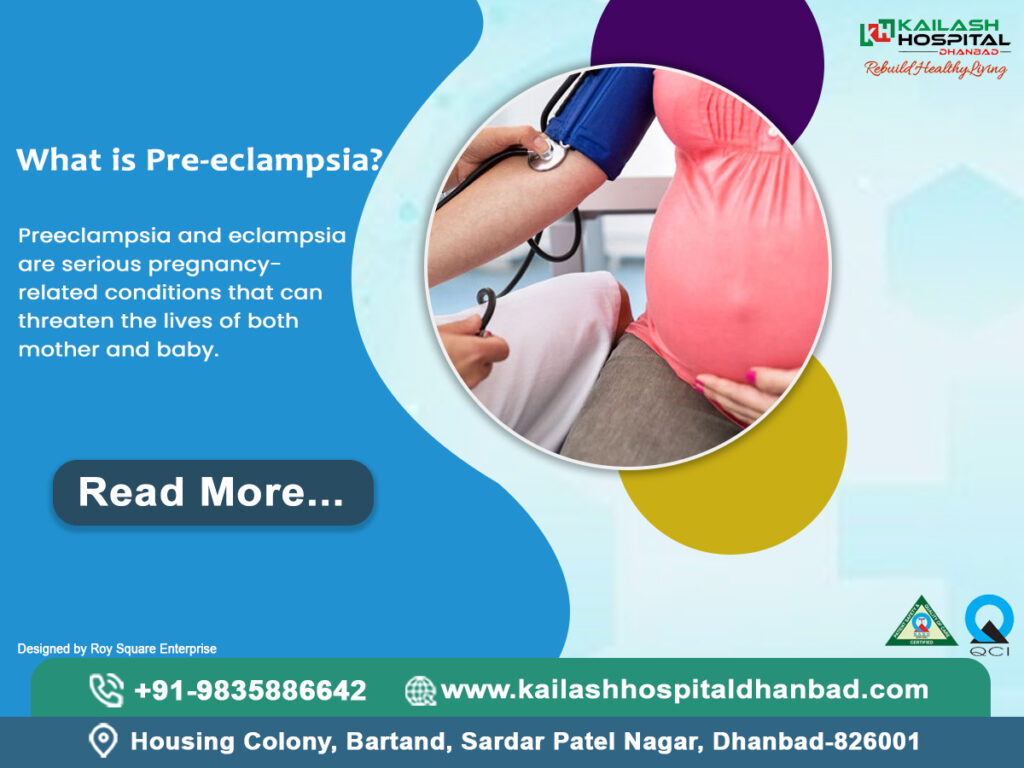
Preeclampsia and eclampsia are serious pregnancy-related conditions that can threaten the lives of both mother and baby. Preeclampsia is a disorder characterized by high blood pressure and signs of organ damage, typically occur- ring after the 20th week of pregnancy. If not treated, it can lead to eclampsia, a dangerous condition that causes seizures.
These disorders affect 5-8% of pregnancies worldwide and are leading causes of maternal and fetal complications. Early detection and proper management are crucial to preventing severe outcomes such as stroke, kidney failure, or even death.
Preeclampsia is a pregnancy-specific condition marked by high blood pressure (hypertension) and signs of organ damage, typically affecting the liver and kidneys. It usually occurs after 20 weeks of pregnancy, but can also appear after delivery in some cases.
What is the Cause of Preeclampsia?
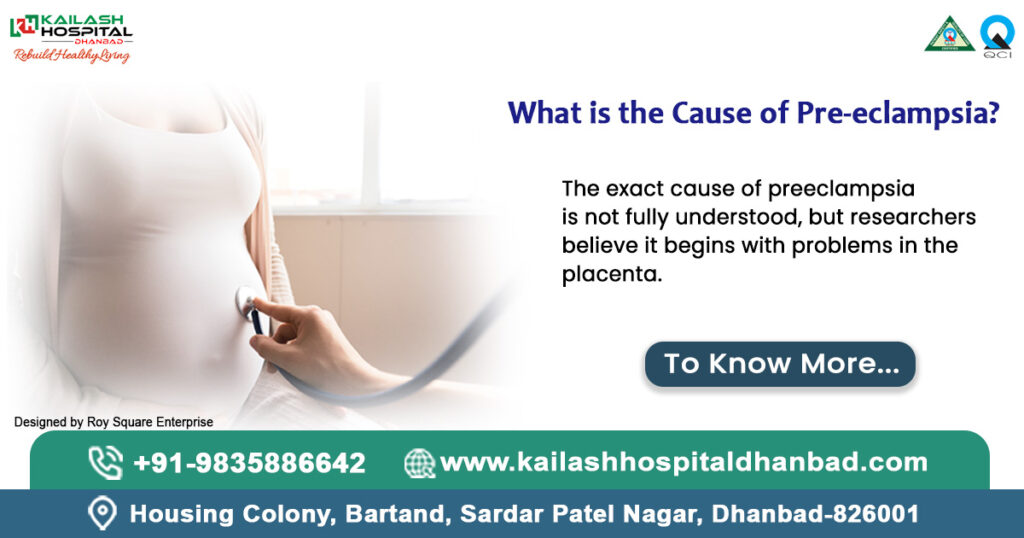
The exact cause of preeclampsia is not fully understood, but researchers believe it begins with problems in the placenta. During early pregnancy, blood vessels in the placenta may not develop properly, leading to reduced blood flow. This triggers a series of reactions, including inflammation and damage to blood vessels throughout the body.
Key Contributing Factors:
1. Placental Dysfunction
- Poor blood flow to the placenta leads to the release of harmful pro- teins into the mother’s bloodstream.
- These proteins cause blood vessels to constrict, raising blood pressure and damaging organs.
2. Genetic Factors
- Having relatives who had preeclampsia raises your chances of getting it too.
- Certain gene mutations may affect blood vessel health.
3. Maternal Health Conditions
- Long-term high blood pressure, diabetes, kidney problems, and being overweight raise the risk.
- Autoimmune disorders like lupus are also linked to higher rates of preeclampsia.
4. First Pregnancy or New Partner
- The immune system may react differently in a first pregnancy or with a new partner, increasing risk.
5. Lifestyle and Environmental Factors
- Bad eating habits, too much stress, and not moving enough can be reasons.
- Understanding these causes helps doctors identify high-risk pregnancies early.
How Common is Preeclampsia?
Preeclampsia occurs in approximately 5-8% of pregnancies, with increased preva- lence among certain groups.
- First-time mothers
- Women over 35 or under 20
- Those carrying twins or triplets
- Women who already have health issues like high blood pressure, diabetes, or obesity.
Severe cases occur in 1-2% of pregnancies, and eclampsia develops in 1 in 200-300 preeclampsia cases.
Symptoms of Preeclampsia
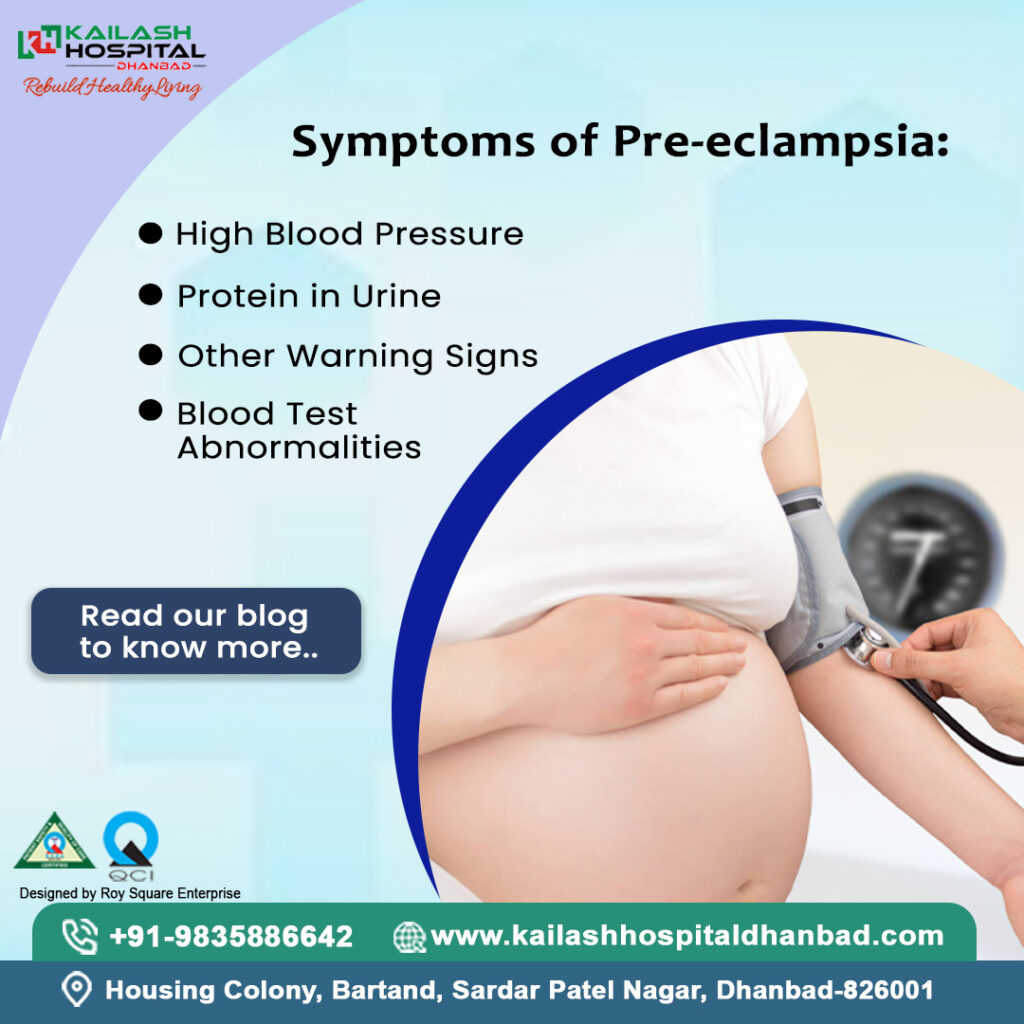
Recognizing the symptoms of preeclampsia early can prevent complications. Common signs include:
1. High Blood Pressure (Hypertension)
- 140/90 mmHg or above in two separate measurements taken 4 hours apart.
2. Protein in Urine (Proteinuria)
- 300 mg or more in a 24-hour urine test or an abnormal urine protein- to-creatinine ratio.
3. Other Warning Signs
- Severe headaches (due to increased brain pressure).
- Vision problems (blurriness, flashing lights, temporary blindness).
- Upper abdominal pain (often under the ribs on the right side, signaling liver stress).
- Nausea or vomiting (especially in the second half of pregnancy).
- Sudden swelling (in the hands, feet, or face—though swelling alone is not diagnostic).
4. Blood Test Abnormalities
- Low platelet count (thrombocytopenia).
- High liver enzyme levels (a sign of liver injury).
- High creatinine levels (signaling kidney problems).
If these symptoms appear, immediate medical attention is crucial.
How is Preeclampsia Diagnosed?
Doctors use several tests to confirm preeclampsia:
1. Blood Pressure Checks
- Two high readings (≥140/90 mmHg) at least 4 hours apart after 20 weeks.
2. Urine Tests
- 24-hour urine test to check protein amount.
- Spot protein-to-creatinine ratio for quicker assessment.
3. Blood Tests
- Complete blood count (CBC) – checks for low platelets.
- Liver function tests (LFTs) – detects liver damage.
- Kidney function tests – assesses creatinine and urea levels.
4. Fetal Monitoring
- Ultrasound – checks baby’s growth and amniotic fluid.
- Doppler flow studies – measures blood flow in the umbilical artery. Early diagnosis helps manage preeclampsia complications effectively.
Treatment for Preeclampsia
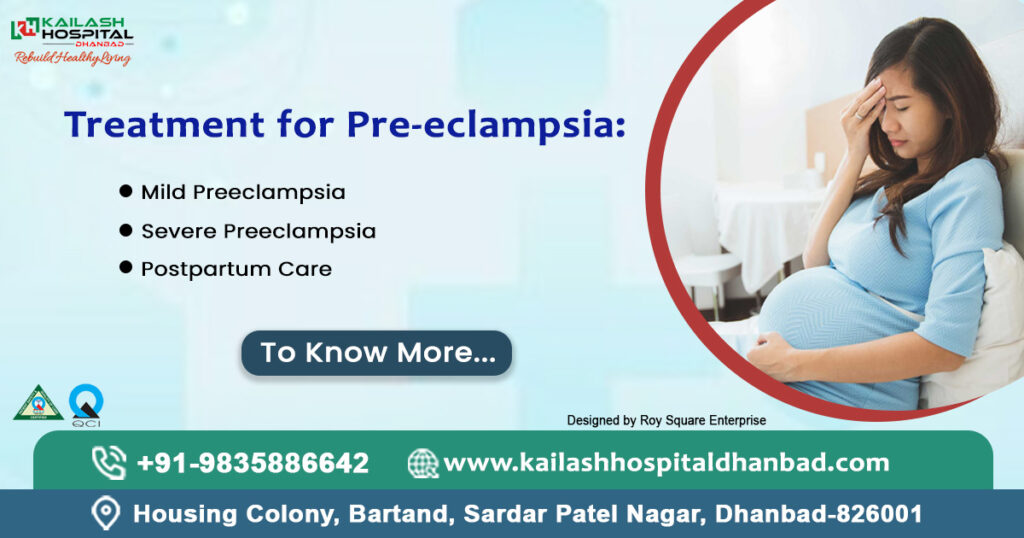
Management depends on severity and pregnancy stage:
1. Mild Preeclampsia (Close Monitoring)
- Frequent check-ups (blood pressure, urine tests, blood work)
- Antihypertensive drugs (if BP ≥150/100 mmHg).
- Early delivery possible if health declines.
2. Severe Preeclampsia (Hospitalization & Delivery)
- Magnesium sulfate (prevents seizures).
- IV antihypertensives (labetalol, hydralazine).
- Delivery is the only cure, even if preterm (after 34 weeks, early delivery is often recommended).
3. Postpartum Care
- Blood pressure monitoring continues for 6 weeks after birth.
- Some women develop postpartum preeclampsia, requiring ongoing treat- ment.
Preeclampsia Complications
Without proper treatment, preeclampsia can lead to:
- Eclampsia (seizures).
- HELLP syndrome (a life-threatening liver and blood clotting disorder).
- Placental abruption (premature separation of the placenta, causing heavy bleeding).
- Stroke (due to extremely high blood pressure).
- Premature birth (leading to neonatal complications).
- Long-term heart and kidney risks for the mother.
Key Differences Between Preeclampsia and Eclampsia :
Preeclampsia and eclampsia are part of the same disease spectrum, but they differ significantly in severity and clinical presentation. Understanding these differences is crucial for timely intervention and management.
Preeclampsia: The Warning Stage
Preeclampsia is a pregnancy-related condition characterized by:
- High blood pressure (≥140/90 mmHg after 20 weeks)
- Signs of organ damage, typically affecting the kidneys (proteinuria), liver, or blood (low platelets)
- No seizures – this is what distinguishes it from eclampsia
It can range from mild to severe, with severe cases showing extremely high blood pressure (≥160/110 mmHg) or significant organ dysfunction.
Eclampsia: The Life-Threatening Complication
Eclampsia is the progression of preeclampsia to seizures (convulsions). Key features include:
- All signs of preeclampsia (high blood pressure, organ dysfunction)
- New-onset seizures (tonic-clonic convulsions) without prior neurologi- cal conditions
- Can happen anytime around childbirth, including up to 6 weeks after delivery.
What is Eclampsia ?
Eclampsia is a serious and life-threatening complication of pregnancy characterized by the onset of seizures (convulsions) in a woman who has preeclampsia (high blood pressure and signs of organ damage), but has no prior history of seizures or epilepsy.
Eclampsia is the severe and life-threatening form of preeclampsia, characterized by the onset of seizures in a pregnant woman with preeclampsia. These seizures are not related to any pre-existing neurological condition.
Causes of Eclampsia
Eclampsia is a severe complication of preeclampsia, marked by the onset of seizures in a pregnant woman who previously had no history of epilepsy or neurological issues. While the exact cause of eclampsia is not fully understood, it is generally considered the result of worsening preeclampsia and its effects on the body.
Here are the main causes and contributing factors:
1. Untreated or Severe Preeclampsia
Eclampsia most commonly develops in women with moderate to severe preeclampsia—a condition involving high blood pressure, protein in the urine, and organ dysfunction.
2. Poor Blood Flow to the Brain
High blood pressure in preeclampsia can lead to cerebral edema (swelling in the brain), reduced oxygen flow, or bleeding, all of which can trigger seizures.
3. Abnormal Placental Development
Improper formation of blood vessels in the placenta can cause poor placental blood flow, leading to systemic inflammation, oxidative stress, and eventually preeclampsia/eclampsia.
4. Blood Vessel Dysfunction
Preeclampsia affects the endothelial cells lining blood vessels, making them leaky and prone to spasms, which may disturb brain function and lead to convulsions.
5. Immune System Abnormalities
Abnormal immune responses between the mother and fetus may contribute to inflammation and placental damage, increasing the risk of eclampsia.
6. Genetic and Environmental Factors
A family history of preeclampsia/eclampsia, obesity, poor nutrition, and lack of prenatal care can increase the likelihood of the condition progressing to eclampsia.
7. Other Risk Factors
- First-time pregnancy
- Teen pregnancy or maternal age over 35
- Multiple gestations (twins, triplets)
- Pre-existing hypertension or kidney disease
- Diabetes
- Previous history of preeclampsia/eclampsia
IMPORTANT
Not all women with preeclampsia will develop eclampsia, but without treatment, the risk increases significantly. Regular prenatal checkups, blood pressure monitoring, and early management are crucial to prevent this dangerous complication.
How Common is Eclampsia?
Eclampsia is relatively rare, especially in regions with access to good prenatal care. However, it remains a serious and life-threatening complication of pregnancy, particularly in developing countries.
· Eclampsia affects approximately 1 in 2,000 to 1 in 3,000 pregnancies in high-income countries.
· In low- and middle-income countries, the rate can be much higher—up to 1 in 100 pregnancies in some regions.
- Among women with preeclampsia, about 1 in 200 to 1 in 400 may develop eclampsia if not treated.
Symptoms of Eclampsia
Eclampsia is a dangerous pregnancy complication where preeclampsia progresses to seizures. Recognizing these signs can save lives:
Key Symptoms :
- Sudden seizures (uncontrolled shaking, loss of consciousness)
- Severe, unrelenting headache (won’t improve with pain meds)
- Vision changes (blurring, flashing lights, temporary blindness)
- Mental confusion or unusual agitation
- Loss of consciousness (in severe cases)
Critical Notes:
- Can strike without warning, even with mild preeclampsia
- Most cases occur near delivery or within 48 hours after birth
- Requires emergency care – magnesium sulfate stops seizures
Treatment of Eclampsia
Eclampsia requires immediate medical intervention to protect both mother and baby. The treatment protocol focuses on three critical objectives:
1. Seizure Control
- Magnesium sulfate is still the best treatment available.
- Administered as 4-6g IV bolus over 15-20 minutes, followed by 1- 2g/hour maintenance infusion
- More effective than diazepam or phenytoin for pregnancy-related seizures
2. Blood Pressure Management
- IV labetalol or hydralazine to rapidly reduce severe hypertension
- Target BP <160/110 mmHg to prevent cerebral hemorrhage
- Continuous maternal monitoring for signs of stroke or organ damage
3. Definitive Treatment
- Delivery is the only cure, performed as soon as the mother is stabi- lized
- Cesarean section often required if vaginal delivery isn’t imminent
- Intensive monitoring continues for 24-48 hours postpartum
How is Preeclampsia Diagnosed ?
Eclampsia is primarily diagnosed based on the presence of seizures in a pregnant woman who has preeclampsia, and no history of epilepsy or other seizure disorders.
Because eclampsia is a progression of preeclampsia, early diagnosis starts with identifying signs of preeclampsia during routine prenatal care.
· The hallmark sign of eclampsia is generalized tonic-clonic seizures (similar to epileptic seizures).
· These typically occur in women with signs of preeclampsia, such as high blood pressure and protein in the urine.
Complications of Eclampsia :
Eclampsia is a life-threatening pregnancy complication that can have serious consequences for both the mother and the baby if not treated promptly. It is the advanced stage of preeclampsia, characterized by seizures, and can lead to multiple complications affecting various organs.
Here are the major complications of eclampsia:
For the Mother:
1. Brain Damage or Stroke
- Seizures and severely high blood pressure can cause cerebral hemorrhage, swelling of the brain, or stroke, which may result in long-term neurological damage or even death.
2. Coma
- Some women may fall into a coma following repeated or severe seizures, requiring intensive care.
3. HELLP Syndrome
- A severe form of preeclampsia involving:
- Hemolysis (destruction of red blood cells)
- Elevated Liver enzymes
- Low Platelet count
This condition increases the risk of liver rupture, bleeding, and organ failure.
4. Kidney Failure
- Eclampsia can impair kidney function, leading to acute renal failure, sometimes requiring dialysis.
5. Liver Damage or Rupture
- Severe eclampsia can cause liver swelling or rupture, resulting in internal bleeding—a rare but often fatal complication.
6. Pulmonary Edema
- Fluid may accumulate in the lungs, causing difficulty breathing and oxygen shortage.
7. Placental Abruption
- The placenta detaches prematurely from the uterus, causing heavy bleeding, threatening both mother and baby.
8. Death
- Maternal mortality remains a significant risk, especially in low-resource settings without access to emergency care.
For the Baby:
1. Preterm Birth
- Eclampsia often requires early delivery to save the mother’s life, which may lead to premature birth and related complications.
2. Low Birth Weight
- Poor blood flow to the placenta can cause fetal growth restriction, resulting in babies born smaller than expected.
3. Stillbirth
- In severe or unmonitored cases, reduced oxygen supply or placental abruption can lead to fetal death in utero.
4. Neonatal Complications
- Babies born prematurely may suffer from:
- Breathing problems
- Feeding difficultiesInfections
- Long-term developmental delays
Top 10 FAQs About Preeclampsia & Eclampsia
1. What is preeclampsia?
Preeclampsia is a pregnancy complication marked by high blood pressure (after 20 weeks) and organ damage (kidneys, liver, or brain). It can be life- threatening if untreated.
2. What causes preeclampsia?
The exact cause is unknown, but it’s linked to placental dysfunction, blood vessel problems, and genetic factors. Risk factors include first pregnancies, chronic hypertension, and obesity.
3. What are the warning signs of preeclampsia?
• Severe headache
- Vision changes (blurring, flashing lights)
- Upper abdominal pain (right side)
- Sudden swelling (face/hands)
- High blood pressure
4. How is preeclampsia diagnosed?
Doctors check:
- Blood pressure (≥140/90 mmHg)
- Urine protein levels (proteinuria)
- Blood tests (liver/kidney function, platelets)
5. Can preeclampsia be cured?
The only cure is delivery of the baby. If diagnosed early, doctors manage it with medication & monitoring until safe delivery.
6. What’s the difference between preeclampsia & eclamp- sia?
- Preeclampsia = High BP + organ damage
- Eclampsia = Preeclampsia + seizures (medical emergency)
7. What triggers eclampsia?
When preeclampsia worsens, it can cause seizures due to brain swelling. Risk factors include very high BP, delayed treatment, or HELLP syndrome.
8. How is eclampsia treated?
- Magnesium sulfate (stops seizures)
- IV antihypertensives (lowers BP)
- Emergency delivery (once stable)
9. Can preeclampsia affect the baby?
Yes. It may cause:
- Premature birth
- Low birth weight
- Placental abruption (dangerous bleeding)
10. Can preeclampsia happen after delivery?
Yes! Postpartum preeclampsia can occur within 48 hours to 6 weeks after birth. Symptoms (headache, high BP) need immediate care.



